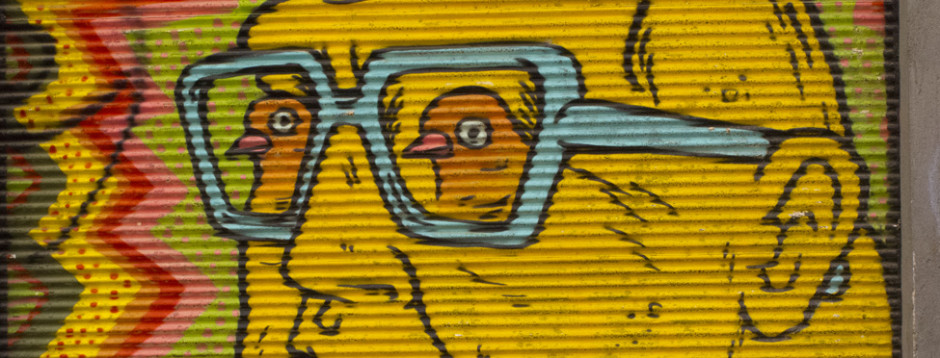in Hyperallergic. February 20, 2015

Marsden Hartley, “Green and Purple Grapes in a Basket” (1928)
OK, full disclosure: I have never been a huge Marsden Hartley fan. I know that Hartley is “important” in modernist art history, but there’s an air of heaviness to his work that simply never moved me. The color and composition have always felt solid and earthbound — just not my cup of tea — although I am appreciative of how important he has been to many artists over the decades. As one of the many ex-pat artists who traveled to Europe in the teens and twenties, Hartley became part of Gertrude Stein’s circle of writers and painters. From there, he traveled to Germany, where I have always thought he probably felt more comfortable with the solid paintings of Franz Marc and German Expressionism than with the Parisian sensibility. He returned to the States permanently in 1930, bringing with him his European aesthetic experiences, which in turn influenced the developing American Modernist painting movement.
So it was with great curiosity that I read of the current show at Driscoll Babcock Gallery, The Earth Is All I Know of Wonder: Contemporary Responses to Hartley, where contemporary artists like Katherine Bradford and David Humphrey riff on Hartley’s paintings. Now THAT piqued my interest. The exhibition is in conjunction with a much larger show, Art Is Long, Life is Short: Marsden Hartley and Charles Kuntz in Aix- en-Provence, that fills most of Driscoll Babcock’s spacious Chelsea digs. This is an extensive exhibition that arrived in New York from the Greenville County Museum of Art in Greensville, South Carolina. It seeks to present and explore the relationship between the work of Hartley and Kuntz, who both lived and worked in Aix at the same time. A worthy show, not a mind blower, but for those who are Hartley fans one can see some worthwhile works that are not often shown publicly.

Charles Philip Kuntz, “Mont St. Victoire in Clouds” (no date given)
The Kuntz paintings are nice in an academic way: safe, polite, classic landscapes of Southern France from a bygone era. Kuntz died at age 30, so there is no knowing how his work might have developed from these early paintings. However, there is one painting that perhaps gives a hint of where he might have gone. It stands out in striking contrast to everything else in the show. “Mont St. Victoire In Clouds” is an almost psychedelic swirl of color and form with a rich surface that thrusts right in your face. It’s beautiful, unfettered by classicism, and very “Modernist” — radically different from the rest of Kuntz’s work. Painted towards the end of his life, the work is a harbinger of where he was heading.
The group show inspired by Hartley’s works is in a small room, and consists of seven painters and eight moderately sized paintings. According to the show’s curator, each artist was offered a preview of the Hartley and Kuntz exhibition and asked to create a response painting specific to a Hartley piece. As stated in the press release, the chosen artists — Katherine Bradford, Jennifer Coates, Holly Coulis, Rachael Gorchov, David Humphrey, Danielle Orchard, and Robin F. Williams — were invited because their work already reflected an interest in or influence of Hartley. The resulting pieces are quite interesting. Each artist has indeed reflected thoughtfully on some aspect of Hartley’s work, yet like handwriting, each is indisputably the work of its creator.

David Humphrey, “Hartley’s Lilies” (2014)
I’m particularly drawn to David Humphrey’s piece “Hartley’s Lilies,” a modest collage and painting that seamlessly mashes Hartley’s bluntly sexualized lily painting (see “Calla Lilies in a Vase” in the main show) with Humphrey’s loose and wry sensibility. It shouldn’t work, but it does, and it’s a painting that is both beautiful and silly — a perfect response to Hartley.

Danielle Orchard, “Picnic in Aix 1″ (2015)
Danielle Orchard’s two paintings have stylistic echoes of Hartley but seem more intent on making a comment on his possible relationship with Kuntz. In both works, two male figures lay supine in an undefined but colorful landscape. Their relationship is ambiguous, but suggestive. The two paintings, of similar gesture but different coloration, pose a quiet comment on Hartley’s inner life. It has long been posited that Hartley was a closeted gay man. Reading between the lines about his relationship with Kuntz, one could suppose that there might have been a deeper connection between the two.
This is a small but intriguing and rich show. Emphasis on the “small.” I left wishing that it had been bigger. Tracing the influence of Hartley and where his modernist sensibility would lead to in the work of contemporary artists is a good starting concept. But there could have been so much more, both in quantity and in commentary on Hartley and his influential life.

Jennifer Coates, “Houseplant” (2014)

Katherine Bradford, “Liner Cloud Berg” (2014)
The Earth Is All I Know of Wonder: Contemporary Responses to Hartley and Art Is Long, Life is Short: Marsden Hartley and Charles Kunz in Aix- en-Provence continue at Driscoll Babcock Galleries (525 West 25th Street, Chelsea, Manhattan) through February 21.
Tagged as: Charles Kuntz, David Humphrey, Driscoll Babcock, Greenville County Museum of Art, Holly Coulis, Jennifer Coates, Katherine Bradford, Marsden Hartley, Rachael Gorchov, Robin F. Williams

It is always a treat to read your commentary on art. Thank you for doing it.
Thank you so very much. Please feel free to tell your friends about this blog, so they too can get the news hot off the press!